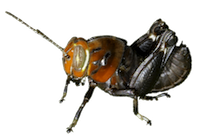Family (Alpha): ACRIDIDAE GRYLLACRIDIDAE GRYLLIDAE GRYLLOTALPIDAE RHAPHIDOPHORIDAE ROMALEIDAE TETRIGIDAE TETTIGONIIDAE TRIDACTYLIDAE
View Gryllidae Members:
Acheta domesticus Anurogryllus arboreus Gryllus unidentified species Gryllus firmus Gryllus fultoni Gryllus pennsylvanicus Gryllus pennsylvanicus/veletis Gryllus pennsylvanicus-veletis Gryllus rubens Gryllus veletis Miogryllus verticalis Velarifictorus micado Hapithus agitator Orocharis unidentified species Orocharis luteolira Orocharis saltator Cycloptilum unidentified species Cycloptilum bidens Cycloptilum pigrum Cycloptilum slossoni Cycloptilum tardum Cycloptilum trigonipalpum Cycloptilum velox Myrmecophilus pergandei Allonemobius allardi Allonemobius fultoni Allonemobius griseus griseus Allonemobius griseus funeralis Allonemobius maculatus Allonemobius socius Allonemobius sparsalsus Allonemobius tinnulus Allonemobius walkeri Allonemobius unidentified species Eunemobius carolinus Eunemobius confusus Eunemobius melodius Eunemobius unidentified species Neonemobius cubensis Neonemobius palustris Neonemobius variegatus Pictonemobius ambitiosus complex Pictonemobius ambitiosus Pictonemobius hubbelli Oecanthus unidentified species Oecanthus celerinictus Oecanthus exclamationis Oecanthus fultoni Oecanthus latipennis Oecanthus nigricornis Oecanthus niveus Oecanthus pini Oecanthus quadripunctatus Neoxabea bipunctata Phyllopalpus pulchellus Anaxipha delicatula Anaxipha exigua Anaxipha litarena Anaxipha rosamacula Anaxipha thomasi Anaxipha tinnula Anaxipha tinnulacita Anaxipha tinnulenta Anaxipha vernalis Anaxipha unidentified species Cyrtoxipha columbiana Falcicula hebardi Gryllidae unidentified species NC Records
Allonemobius walkeri Howard & Furth, 1986 - Walker's Ground Cricket
Taxonomy
Family: Gryllidae
Subfamily: NemobiinaeTribe: PteronemobiiniComments: One of ten species in this genus, all of which occur in North America north of Mexico (Cigliano et al., 2017). Eight species have been recorded in North Carolina.
Identification
Field Guide Descriptions: Online Photographs: BugGuide , Google Images ,
iNaturalist , GBIF Technical Description, Adults/Nymphs: Howard and Furth (1986)SINA 529a.htm Comments: A red-brown to blackish ground cricket (following Alexnder and Thomas's description of allardi). The head is brown with two to three darker stripes, which are usually not contrasting, particularly at the rear of the head, but forming more distinct spots at the top. Differs in coloration and pattern from A. socius, which has pale, contrasting stripes on the back of the head, and from A. tinnulus, which has a more reddish head and pronotum. However, walkeri cannot be safely distinguished from A. fultoni and allardi based on photos and can only be identified based on specimens or by spectrogram (Howard and Furth, 1986).Total Length [body plus wings; excludes ovipositor]: 9.9-11.7, males; 9.2-11.7, females (Howard and Furth, 1986)Structural Features: Males have 183-208 stridulatory teeth, which is well above the range of fultoni and averaging lower than allardi, but overlapping in range (Howard and Furth, 1986). Walkeri is significantly larger than fultoni in all measurements, with a table listing these measurements presented by Howard and Furth.Singing Behavior: The song of Allonemobius walkeri consists of a long, irregularly broken series of downslurred pulses (see SINA), similar in shape to A. tinnulus, allardi, and fultoni. According to Howard and Furth (1986), walkeri sings at a faster rate than allardi, producing 24-25 pulses per second at 23 degrees C compared to 13-16 for allardi (and still fewer for tinnulus); the dominant pitch ranges from 6.7 to 7.7 kHz. While they found no differences between walkeri and fultoni in terms of dominant pitch or rate of singing, the songs of fultoni are more regularly broken into segments separated by fairly fixed intervals of silence (fultoni also appears to differ in terms of habitats).Recording playback at normal speed.
Download Video:
"MP4"
Distribution in North Carolina
County Map: Clicking on a county returns the records for the species in that county.
Adult Dates: Click on graph to enlarge
Habitats and Life History
Habitats: According to Howard and Furth (1986), A. walkeri inhabits dry grassy fields and pastures, nearly always co-occurring with A. allardi, at least where their geographic ranges overlap. Records from North Carolina include an upland field dominated by Andropogon virginicus; a grassy powerline in a floodplain; and an area of old field habitat also located in a floodplain. Diet: Probably omnivorousObservation Methods: Most easily detected by its songAbundance/Frequency: Usually heard as single indivdualsAdult Phenology: Adults emerge in late summer and fall; eggs overwinter (Howard and Furth, 1986)
Status in North Carolina
Natural Heritage Program Status: Natural Heritage Program Ranks: [GNR] S3S4State Protection: Has no legal protection, although permits are required to collect it on state parks and other public landsComments: Although this species appears to be associated with common types of habitats, it was considered rare by Howard and Furth (1986). Not enough is yet known about its distribution, abundance, and habitat preferences, however, to accurately assess its conservation status.
Image Gallery for Allonemobius walkeri - Walker's Ground Cricket Recorded by: Steve Hall Recorded by: Steve Hall Recorded by: Stephen Hall Recorded by: Steve Hall and Dee Stuckey Recorded by: Steve Hall Recorded by: Steve Hall and Dee Stuckey Recorded by: Steve Hall

 »
»
 »
»